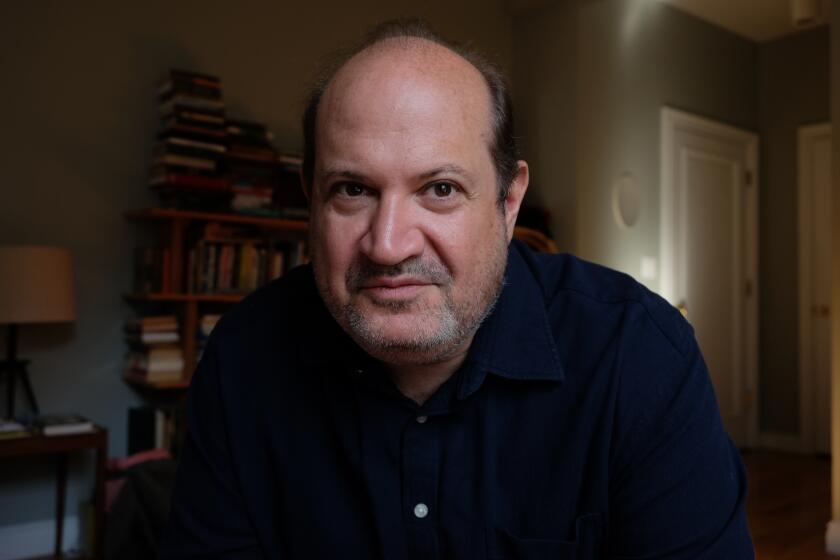Manhattan on the rocks: A novel’s dual homage to ’90s New York and a legendary author

- Share via
Review
Vintage Contemporaries
By Dan Kois
Harper: 336 pages, $28
If you buy books linked on our site, The Times may earn a commission from Bookshop.org, whose fees support independent bookstores.
If you’d been able to view my bookshelves in the 1990s, you’d have seen dozens, if not scores, of Vintage Contemporaries — editions of the imprint founded in 1984 to funnel hundreds of au courant Knopf titles into trade-paperback form — from Richard Russo, Ann Beattie and the ’80s literary Brat Pack on through the youngish stars of subsequent decades (Sapphire, Jenny Offill, Hari Kunzru).
The imprint made great fiction cheaper and easier to tote in backpacks and diaper bags, but now that they’ve ceded supremacy to e-books and audiobooks, these editions — especially the older ones, with their jazzy neon covers — evoke a slightly retro feel. That may be one of the reasons Dan Kois, a longtime books editor at Slate, chose the label as the title of his debut novel; “Vintage Contemporaries” follows two friends, both named Emily, who land in Manhattan in the early 1990s with different backgrounds and dreams.
Emily the narrator — “Em” when she’s with the other Emily — came to New York from suburban Wisconsin with vague notions of working in publishing but precious few credentials or connections. She manages to land a job as assistant to a literary agent named Edith Safer, “of the old school,” the very model of an éminence grise. In another stroke of luck, her mother mentions an old college friend named Lucy Deming who has a few books in need of a publisher.
In ‘How to Be a Family,’ Dan Kois shares the ups and downs of dragging his kids around the world.
Lucy is blunt about her goals: “In a nutshell, I would like to make some money this time, so I can stop writing instruction manuals for digital watches.” Em is happy to oblige after reading the novel (“It was a little corny, but it wasn’t incompetent or embarrassing”), and earns Lucy a healthy advance. In short order, Em is recruited into Lucy’s “Upper Upper West Side” life, spending time with Lucy’s daughter Sarah, cooking together, soaking in the beauty and peace with which Lucy surrounds herself in a city with little of either to spare. It’s a world away from the communal Lower East Side squat that Emily, an aspiring artist from Athens, Ga., calls home.
From apartment decor to food obsessions and even her path to publication, Lucy bears a striking resemblance to a real-life Vintage Contemporaries author. Laurie Colwin, who died in 1992 at age 48, might be best remembered today for her volumes “Home Cooking” and “More Home Cooking,” discursive collections of recipes and memories that some of us still rely on when making a roast chicken or baking the best gingerbread. Kois even uses “front-cover copy” from the Pocket Books paperback of Colwin’s novel “Happy All the Time” as an epigraph: “Life never worked out so well! Love never had it so good!”

Colwin was known in life as in writing for her cheer and bonhomie, as well as her ability to create a dinner party in the smallest bedsit. Kois’ homage plays out and contemporizes Colwin’s cockeyed optimism, using a well-worn but heartfelt story of two friends on divergent paths — Em forging a career and a family, Emily foundering for years before finding her way — to show that not everyone has to live a magical life to survive in the big city.
As Emily descends into an abusive relationship and drug habit, the friends become estranged and Em is pulled further into Lucy’s orbit. And as Lucy begins succumbing to a degenerative illness, she moves to push family away — offering Em, indirectly, a lesson in both the shortness of life and the possibilities of reconciliation. We can make grievous mistakes out of love, but that doesn’t obviate our connections or our obligations. Love never had it so good.
On a literal level the “vintage contemporaries” in this book are Em and Emily, friends of the same age who simultaneously come of age. But the title also feels like a nod to the imprint’s reissue of several Colwin books last year. (Full disclosure: I wrote a blurb for these titles.) In mashing up his characters’ experiences with Colwin’s, Kois not only brings a certain lightness to decades that are as full of loss and angst as they are of discovery and triumph; he reminds us that darkness and light always coexist.
The author, who died in 1992, has ten reissues coming out this year, and she’s exactly the happy, cozy writer we need in a time of strife and quarantine.
Which brings me to my one problem with this novel: too much coexisting. Kois toggles among so many different scenes and characters that I sometimes wished he had made some more of his own hard choices. He could have focused more on the relationship Em and Lucy, or Em and Emily — or more on both if he’d taken out bits about the Strand bookstore, the intricacies of book publishing, late-night parties followed by pierogi at Veselka — elements that can be fun, but in their profusion felt stuck somewhere between atmosphere and subplot.
One major subplot does bear fruit, in its way: Em and Emily work hard, toward the end of the story, to help longtime members of Emily’s former squat protest a city takeover. Their efforts come to naught, but it doesn’t matter. Em has moved to Inwood with her family. Emily will disappear, like so many of the people from our early years. We close on Em, still editing, though contemplating the leap to writing books of her own.
Life goes on. The city remains unsleeping. Young people arrive, some stay and some go, some succeed and some fail. Some observe, the better to remind us of their time and place in the stories they will later tell. Em at one point tells her daughter, “I’m always watching.”
In “No One Left to Come Looking for You,” Sam Lipsyte, master Gen-X satirist, follows a shambolic ’90s punk band through a grungy New York mystery.
Although Kois now lives in Northern Virginia, his recollections of 1990s Manhattan tell us that he was too. “Vintage Contemporaries” is crammed a bit too full of plot, not unlike the cramped city it documents. Fortunately, it’s also overstuffed with bittersweet beauty, not unlike the vintage contemporaries of Laurie Colwin.
Patrick is a freelance critic who tweets @TheBookMaven.
More to Read
Sign up for our Book Club newsletter
Get the latest news, events and more from the Los Angeles Times Book Club, and help us get L.A. reading and talking.
You may occasionally receive promotional content from the Los Angeles Times.










